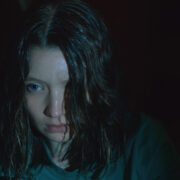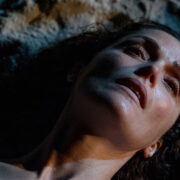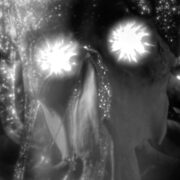THE WAVES OF MADNESS: Cthulu Cruise Adventure Is All Love And Craft
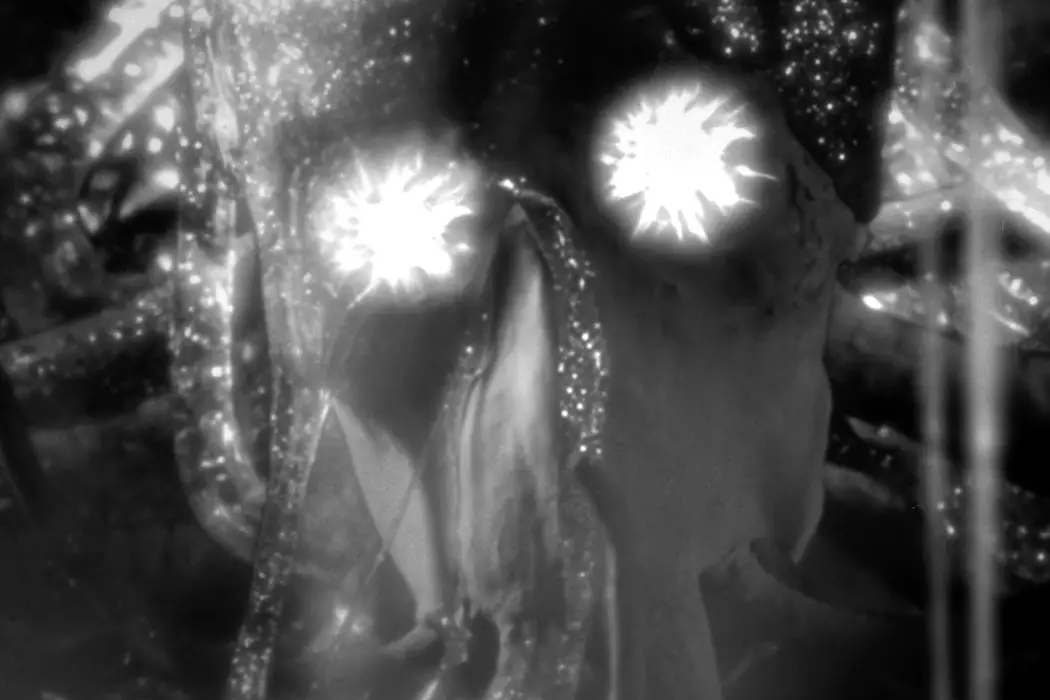
Film critic, Ithaca College and University of St Andrews graduate,…
The Waves of Madness has been marketed as “the world’s first side-scrolling horror film.” Its director, writer, and producer, Jason Trost, stars as Legrasse, a Snake Plissken-esque badass secret agent who’s dispatched to a cruise ship to investigate after a Lovecraftian being attacks. Trost is a veteran of the Australian independent cinema scene, and this is his ninth feature film. As with most quality independent microbudget film, this movie came to me via Reddit, where Trost was promoting it. I remembered seeing the trailer what felt like ages ago, and at barely over 60 minutes, it’s hard to say no to The Waves of Madness.
As a filmmaker, Trost’s guiding principle seems to be that no idea is too crazy to work — after all, he made three sequels to his debut film, The FP, a post-apocalyptic movie about a Dance Dance Revolution tournament between street gangs. To his credit, the side-scrolling style of The Waves of Madness, which makes the film feel like an old SEGA arcade game, works pretty well — I’m not sure that many films would benefit from being made in this style, but The Waves of Madness mostly pulls it off. At any rate, it’s the most successful aspect of a production where almost nothing else works.
An Action-Horror With No Scares and Bad Action
I try in my criticism to champion low-budget labors of love when I can find them, and I have no doubt that it took Trost a tremendous amount of love and craft to bring The Waves of Madness to the screen. So it brings me no measure of joy to say that The Waves of Madness is a few carnivals short of a cruise. Most films have characters and stories, but Waves seems content to have a video game character as its hero and barely any story beyond its own logline. (A cruise ship is attacked by Cthulu, and a gun-toting secret agent investigates.) Agent Legrasse is a dull, poorly acted character — Trost’s eyepatch, which he has in real life, at least serves as a fun reference to Kurt Russell’s Snake Plissken, but the eyepatch and the gun seem to be 90% of the performance. Trost has an unplaceable accent, with a Southern twang that comes and goes as often as he has to reload the single pistol he brought with him. With such terrible dialogue, usually the blame here would fall on whoever wrote the script, but that was Trost’s work as well. The supporting characters are equally insufferable, especially Tallay Wickham as the golly-gosh damsel in distress, whose every line sounds ADR’d and who speaks in a high, panicked register that gets extremely irritating extremely quickly. These are not elements that require a budget, either — it’s a catastrophic decision at the script and story level that trickles down into the rest of the production.
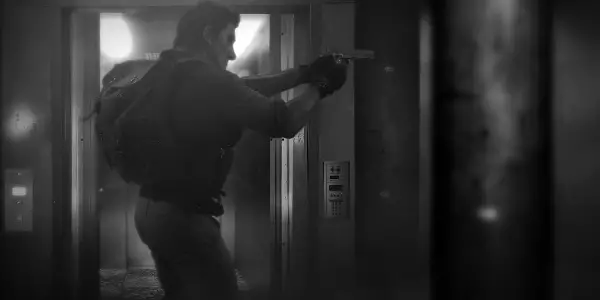
The pacing is all over the place, too. This is a 68-minute-long film, 12 minutes of which are closing credits and a mid-credits scene that threatens us with a sequel. So it’s really closer to 56 minutes. And then there’s the nine-minute introductory scene and opening credits, in which a drunk man wanders around the bar and casino floor and then meets Cthulu. The hero doesn’t even get introduced until after the opening credits, so the actual meat of the film is more like 47 minutes. The action doesn’t even get started right away, with eons of buildup before Legrasse starts fighting monsters. In that time, the film lost any goodwill it had at the start. I ran out of patience and charity and just got pissed off.
The horror isn’t scary because the film is nearly entirely visual effects, and there’s only so much tension that can be squeezed from the characters running from a CG monster in a flat wide shot. The action is dull, because it’s just one person shooting and moving to the side like a video game hero. It’s like watching someone else play A Nightmare on Elm Street on the NES. One scene where they drive a car through the casino is particularly lifeless — and, after the twist ending, it also doesn’t make a lick of sense. You can feel that the limited cast had fun shooting this, and I’m glad they realized their vision. But their vision entirely comprises lines, characters, and plot points lifted from better movies, from the badass taciturn secret agent to the millionth dead wife backstory in an action film.
Ropey and Cheap Visual Effects and CGI
I wish the effects were better, since that would typically be the saving grace for something like this. Alas, the visual effects here are just as bad as you would expect — the muzzle flashes are as fake as the digitally inserted fog, which suffocates every frame of the film and has the dual functions of adding atmosphere and obscuring the ropey CGI. The film is in black and white, too, for no discernible stylistic reason — the films this is harkening back to, like Escape from New York, are not black and white, nor are the games it’s emulating like Resident Evil or Silent Hill 2. So that, too, must be to help hide the bad visual effects.
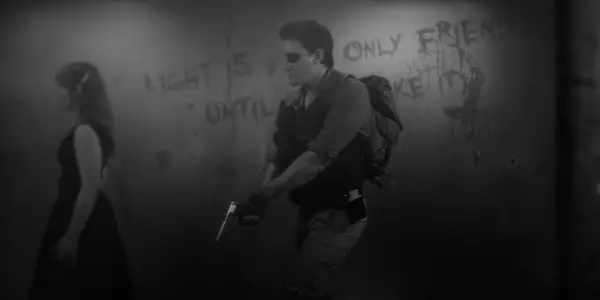
The big Cthulu creature and a pulsing black cloud of arms are both decent CG entities, and the Cthulu monster especially shows off Trost’s creativity when it comes to creating digital effects. But it’s the rote stuff that drags down The Waves of Madness, like the post-production lens flashing, the multitude of elements added to the foreground to make it all look like one seamless take, and the lousy compositing of simple elements like doors into the frame.
The effects are on par with the (intentionally bad?) Kung Fury, that crowd-funded ’80s throwback cheesefest in which a ninja goes back in time to roundhouse-kick Hitler to death. Except this costs money to rent, and Kung Fury was uploaded to YouTube for free. Come to think of it, The Waves of Madness, though it’s much less funny and has only a fraction of Kung Fury’s ambition, feels calibrated to appeal to that same audience of Redditors and ironic cinema enjoyers, for whom passion and creativity vastly outweigh quality and talent.
While Kung Fury (which I have no special affection for) feels like a movie made with full awareness of the limits of the computer animators, the problem with The Waves of Madness is that the film seems to have been made despite those limitations. The effects on order here are magnitudes grander than Trost can achieve believably in post-production. Hopefully on his next outing, he can plan for his own limitations now that he’s greatly overreached.
Conclusion
Ninety-five percent of The Waves of Madness was shot on a green screen in an apartment the crew rented out. The remaining 5% was shot in a motorboat parked outside. When did this become the gold standard of indie filmmaking? Sometime between Star Wars: Episode I — The Phantom Menace and this, computer effects have become so democratized, ubiquitous, cheap, and easy that cinephiles have just totally embraced them as the essential building blocks of low-budget films. The result is that so many low-budget films are made completely in computers now.
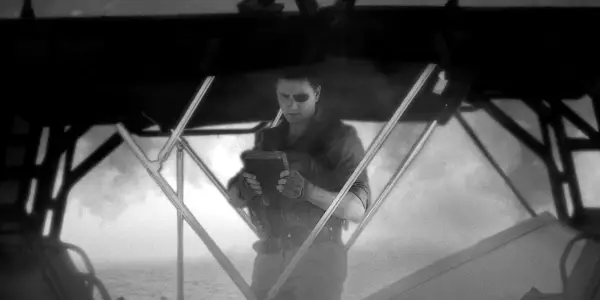
This isn’t a reality I want — I’d much rather see micro-budget films shot on actual sets, with actual fog effects and actual exteriors. But we’ve already come down this road. We’ve already allowed our standards to fall so low that many, many film fans are celebrating work like The Waves of Madness for its originality and the perseverance and vision required to bring it to life. But most of the vision of The Waves of Madness was realized in post-production software at the expense of basic elements like believable and practical production design, good sound design and mixing, good performances, and a solid script.
I’m sure Trost would agree with me that AI has no place in cinema production, yet stuff like The Waves of Madness is only making it easier for AI to gain a foothold in moviemaking. When you can shoot an entire film on a green screen with pre-rendered backgrounds and nearly every prop, background, and effect is a computer-generated asset, it’s easy to simply remove the humans from the process altogether. And while many are lauding the vision of The Waves of Madness — and have actively funded it on Indiegogo — I see it as part of a slippery slope that, if we’re not careful, will one day lead to AI proliferating in low-budget indie film production.
The Waves of Madness is available to rent on YouTube, Amazon Prime, and Apple TV.
Does content like this matter to you?
Become a Member and support film journalism. Unlock access to all of Film Inquiry`s great articles. Join a community of like-minded readers who are passionate about cinema - get access to our private members Network, give back to independent filmmakers, and more.
Film critic, Ithaca College and University of St Andrews graduate, head of the "Paddington 2" fan club.









